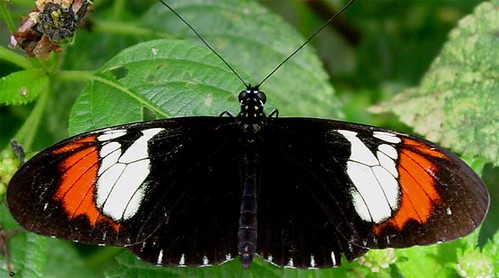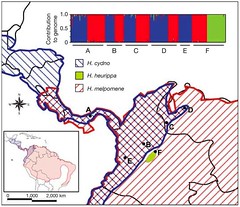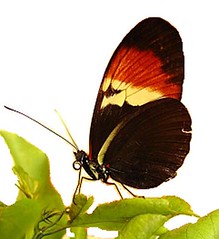
Wild specimen of the butterfly species, Heliconius heurippa.
Researchers recently demonstrated that this species is a naturally-occurring
hybrid between H. cydno and H. melpomene.
Image: Christian Salcedo / University of Florida, Gainesville.
Speciation typically occurs after one lineage splits into two separate and isolated breeding populations. But it is has been hypothesized that two "parental" species with overlapping ranges could hybridize, thereby giving rise to one new but reproductively isolated "daughter species" in the same area. However, this phenomenon has rarely been observed in animals, even though it is known that such "hybrid species" do occur in plants.
But recently, a group of scientists at the Smithsonian Tropical Research Institute in Panama revealed that it took them only a few months in the lab to recreate the wing pattern color of the wild butterfly species, Heliconius heurippa (pictured, top), by hybridizing two closely related species, H. cydno and H. melpomene, that are found in the same area.
These butterflies all have wings that are primarily black, but the specific markings differ between each: H. cydno (left, above) has a pale yellow wing bar; H. melpomene (right, above) has reddish orange wing bar; and the hybrid daughter species, H. heurippa, has both reddish orange and pale yellow wing bars (middle, above).
 A co-author of the study, Mauricio Linares from the University of the Andes in Colombia, suspected that H. heurippa was a hybrid daughter species of H. cydno and H. melpomene because H. heurippa's wing pattern is intermediate between these two species and because it naturally occurs where these other two species have overlapping ranges in northern South America (see map, right; blue lines; H. cydno; red lines, H. melpomene; green blob, H. heurippa. Click for larger view in separate window).
A co-author of the study, Mauricio Linares from the University of the Andes in Colombia, suspected that H. heurippa was a hybrid daughter species of H. cydno and H. melpomene because H. heurippa's wing pattern is intermediate between these two species and because it naturally occurs where these other two species have overlapping ranges in northern South America (see map, right; blue lines; H. cydno; red lines, H. melpomene; green blob, H. heurippa. Click for larger view in separate window).
To test this hybrid daughter species hypothesis, wild specimens of H. cydno and H. melpomene were captured and crossbred in the lab. The wing color markings on the lab-created hybrid (pictured, right) are nearly identical to those of wild H. heurippa (compare to wild specimen at top).
 "We found that a wing pattern almost identical to that of the hybrid can be obtained in months -- just 3 generations of lab crosses between H. cydno and H. melpomene. Moreover, natural hybrids from San Cristobal, Venezuela, show wing patterns very similar to H. heurippa, further supporting the idea of a hybrid origin for this species," said Jesús Mavárez, Molecular Evolution Fellow at the Smithsonian Tropical Research Institute and lead author of these elegant studies that were recently published in the top-tier journal, Nature.
"We found that a wing pattern almost identical to that of the hybrid can be obtained in months -- just 3 generations of lab crosses between H. cydno and H. melpomene. Moreover, natural hybrids from San Cristobal, Venezuela, show wing patterns very similar to H. heurippa, further supporting the idea of a hybrid origin for this species," said Jesús Mavárez, Molecular Evolution Fellow at the Smithsonian Tropical Research Institute and lead author of these elegant studies that were recently published in the top-tier journal, Nature.
Further, Mavárez and his collaborators found that DNA from their newly-created hybrid was nearly identical to that of its wild counterpart, H. heurippa. Additionally, the parental Heliconius butterfly species and their hybrid daughter species all have the same number of chromosomes, a rare situation known as "homoploid hybridization".
This contrasts with mules, which are hybrids of a male donkey and a female horse. A mule possesses an intermediate number of chromosomes between its two parents (horse, 64 chromosomes; donkey, 62 chromosomes; mule, 63 chromosomes) and thus, is infertile. This unpaired chromosome in mules serves as a barrier to reproduction and prevents genes from moving from one species into another.
Interestingly, in their lab experiments, the researchers found that the first generation of female hybrids were sterile, although the males are not. So they bred the hybrid males with females from the parental species until a fertile female hybrid was born. This process is called "backcrossing" and is commonly used today by farmers to preserve desirable traits in captive animals and plants.
After backcrossing, Mavárez's group found that the hybrid butterfly wing patterns remained unchanged. This evidence, combined with the DNA data, suggests that wild H. heurippa males bred with females of one of its parent species until fertile female hybrids were born.
"The fact that the H. heurippa pattern can be generated by laboratory crosses between H. melpomene and H. cydno, and is also observed in wild hybrids between the two species, establishing a probable natural route for the hybrid origin of H. heurippa," the authors wrote in their paper.
Because these Heliconius species live in the same area, the new hybrid daughter species had to establish and maintain reproductive isolation from both its parents to become a distinct species of its own. Since wing pattern is known to be a very efficient visual cue among butterflies for recognizing and selecting a mate of the appropriate species, the researchers then tested the role of wing pattern on mate choice to identify which pattern was most attractive to these species. As expected, they found that wing pattern was a strong cue for the parent butterfly species, but they also discovered that the hybrid butterflies overwhelmingly preferred to mate with other hybrids when they were given a choice.
"If you cover the red or the yellow stripe of a bi-colored hybrid female, hybrid males no longer find her the least bit attractive," Mavárez noted.
In the wild, mate choice plays a powerful role in reproductive isolation.
In addition to distinct mate choice preferences, other behavioral differences were noted in these butterflies. For example, even though they live in the same areas, each species uses the habitat differently and has a different host plant preference.
Interestingly, two other species in the Heliconius group, H. timareta and H. pachinus, are also thought to result from hybridization between H. cydno x H. melpomene.
"We will feel very fortunate if there are more hybrid species in this group," Mavárez said. "Cases of [wild] hybrid animal species are extremely rare and you're very lucky to have one in your preferred group. So, imagine our excitement about the possibility of finding several hybrid species in Heliconius. A whole new set of questions could be addressed."
Currently, the scientists are identifying the specific genetic contribution of each parental species to the genome of H. heurippa as they further investigate this type of speciation event. Homoploid hybridization is thought to have played a role in the rapid speciation of African cichlids (fish) and Rhagoletis flies, both of which are well-studied, but this is the clearest evidence to date in support of the role of homoploid hybridization in the creation of new species.
.
Sources:
Speciation by hybridization in Heliconius butterflies (2006). by Mavarez, J., Salazar, C.A., Bermingham, E., Salcedo, C., Jiggins, C.D. , Linares, M. [Nature, 441:868-872, 15 June 2006; doi:10.1038/nature04738] [images, quotes]
Also see;
Making the Paper: Jesús Mavárez. [Nature, 441:xi, 15 June 2006; doi:10.1038/7095xia]
EurekaAlert [quotes]
Note to readers: PDFs available by request.
.
![]()
The Tangled Bank, issue 56,
which celebrates the best writing about science, nature and medicine on a blog.
Included in the Carnival of the Vanities, 198th edition,
which celebrates the best blog writing on any topic.
Darwin is Dead blog carnival, July Issue.
.


This is fascinating, thank you. Ever since I read some wheats are hybrids, I've wondered when something like this would turn up in animals. I'm also reminded of the old multi-regionalism hypothesis for human evolution, which seemed to require hybridization.
A question - what implications (if any) does hybridization have for cladistics?
I guess I'm a paid up member of the British PopGroup scene: I saw that photo an immediately thought "Heliconius". Can't tell which species it is, though.
Llewelly: hybridisations have been known in animals, but tehy tend to be between fairly close species, as in Heliconius or Rana (water frogs). Cereals can hybridise over longer phylogenetic distances. Several important agronomic genes were introduced into wheat from rye in this way (there's the 1B/1R translocaton that I heard about too often during my PhD). Apparently there are even wheat/barley hybrids in existance.
Oh, and for more on Heliconius, check Jim Mallet's web page.
Bob
I vote for speciation by hybridization in animals to be more common than true sympatric speciation (ie, complete overlap).
This is fascinating and very clear: evolution has been inferred in the wild and duplicated in the laboratory, thus confirming its wild occurrence unless a countervailing mechanism is found. Excellent!